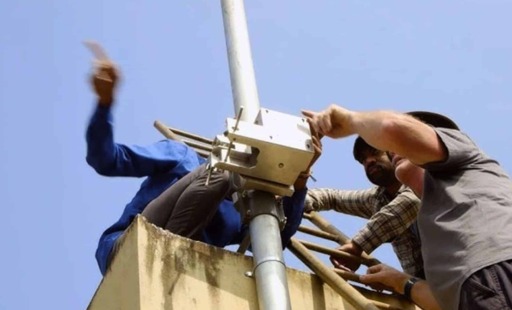The problem with laser communication is that it doesn’t take much rain, snow or fog to block the signal.
Similar “free-space optics” systems have been tested since the late 1990s, but past attempts were limited by weather conditions and fragile alignment systems. Taara claims its devices overcome many of those limitations with improved beam tracking and more resilient design.
They claim they’ve overcome that hurdle though, as per the article.
Yes, but the article is literally nothing without that information.
The only interesting thing about a new approach to laser internet is if they’ve solved the critical issue holding it back.
I wonder what they did, though. Because the article is omitting most of the interesting details and frames it as if this as if optical communication in itself was something new or disruptive… I mean if I read the Wikipedia article on Long-range optical wireless communication, it seems a bunch of companies have already invested 3 digit million sums into solving this exact issue…
Well, most likely they’ll never say what they did to solve it, assuming it is solved. That’s how capitalism works. Everyone tries to keep innovation secret, so we have to invent the same thing dozens of times.
Nah, all it takes is one person buying it, disassemble it and look at the mechanics to see whether there are things like motors and mirrors inside the transmitter to do new things like align it dynamically. And I mean the other things, physics, the atmosphere, lenses and near infraread lasers along with signal processing are well-understood. I think it won’t be a big secret once it turns into a real thing… I mean as long as it’s hype only it might be.
Maybe, though processes and algorithms won’t be copied easily legally. If they did some special coating to lenses or something, or if they have a really smart algorithm to correct for different effects, those are protected by law. You can examine it and try to replicate it, but you can’t copy it.
Sure. I think we’re talking a bit about different things here. I didn’t want to copy it, just know how it’s done 😆 But yeah, you’re right. And what you said has another benefit. If they want to protect it by law, we have a process for that: Patents. And those require to publish how it’s done…
Okay, photo taken (by Gabriele Barni) from 17.1177 km (claimed metric kilometers) straight distance to the buildings:

.You can imagine how wobbly the image was.
How to compensate it? Wide, powerful beam? Gonna be blinded by an invisible light?
Quote from the video:
This is as simple as a digital camera with a laser pointer.
claimed metric kilometers
As opposed to imperial, customary or nautical kilometres?
Yes
The company now operates in 12 countries and employs around 20 people.
That sounds like hard work.
20 people are probably the executives and upper management. The 90% of the company is filled by contractors
Just lay fiber. Stop. Just lay fiber.
Right? It seems like there’s no reason to consider this niche solution except for crossing bodies of water as a last mile connection. Is there some shortage of fiber or just security concerns prompting all this investment?
If South Dakota can do it then its possible anywhere
Not very compareable systems. One covers the entire globe with satellites and another is just a fancy version of Wi-Fi. If you live somewhere remote you’d still need a bunch of masts within line of sight from eachother and if you’re vanlifer or such then it’s of no use.
I mean, cool technology but serves a bit different purpose. Especially in the edge cases.
Hang on that’s not a fair comparison. So you will need to deploy some masts to reach remote areas, got it.
Satellite internet then needs to fire a satellite into space to cover the area of which now there are thousands of then And the satellite has a shelf life and will eventually burn up in the atmosphere requiring repeated deployments.
Masts sounds easier.
You need quite a bit of masts to cover the entire globe and that still doesn’t work in places like in the middle of the ocean. Satellites most likely are easier to deploy and cheaper as well.
I don’t think this technology is intended to be used for global internet. But for giving access to a remote town, this is many magnitudes lesser in cost than a satellite.
A brief internet search tells me that a Starlink satellite is ~$1 million apiece, and lasts 5 years. With the additional cost of the launch the annual cost is ~$300,000 per year per satellite. You can work out the cost for 10 masts and tell me that its much cheaper.
From a consumer perspective, Starlink is amazing. Fast, relatively cheap, available anywhere. From a labour and material cost, its incredibly expensive. If a town can be serviced by cable, wireless, this new laser or whatever then the economical and environmental impact (in terms of materials) are a fraction.
Whilst masts will face the same prejudice as windmills for destroying landscapes, Starlink has already been causing issues with stargazing and night sky pollution. And this is only the first commercial venture for low-orbit internet. I can imagine there shall eventually be multiple of these setups, each with thousands of satellites (Starlink is at 7k+ now I think) which will only exacerbate the issues.
The point being, that having other technologies with overlapping abilities isn’t a bad thing. Choice is good.
and it requires line of sight which means it is hard to scale, will have issues with adverse climate and probably will need frequent realigments
Imagine an autolock laser connection to the signal tower. Or autolock laser to a satellite in a vanlife.
Then imagine clouds. Pigeons.
The bandwidth of IPoAC is considerably lower, though.
Imagine a rainbow on a cool spring day.
Picture yourself in a boat on a river.
Taara is Google, just saying.
“has just broken free from Alphabet”
10 to 100 Times less reliable than WiFi
Do you mean the tech that has existed since forever ago and that was replaced by microwaves?
Asked cgpt to compare lasers to microwave for data transmission; take with a grain of salt, but seems transfer rate especially isn’t comparable.
🔄 Comparison: Laser vs Microwave Data Transmission
📋 Comparison Table
Feature Laser Transmission (e.g., Taara) Microwave Transmission Medium Free-space optical (light, like a fiber-optic cable without fiber) Radio/microwave frequencies (GHz range) Wavelength ~780–1600 nm (near-infrared) ~1–100 GHz Typical Data Rate 10–100 Gbps (Taara targets ~20 Gbps and higher) 100 Mbps – 1 Gbps (modern line-of-sight microwave) Max Practical Range ~10–20 km, highly sensitive to weather ~30–50 km, more tolerant of weather Line-of-Sight Requirement Yes, with tight beam alignment needed Yes, but more forgiving alignment Weather Sensitivity High — fog, rain, dust degrade performance Moderate — heavy rain can attenuate signal Latency Low Low Power Usage Lower power for same data rate Slightly higher power use Security High — narrow beam, hard to intercept Moderate — wider beam, easier to jam or intercept Deployment Harder — requires precision mounting and stability Easier — flexible mounting, ruggedized equipment Cost Higher upfront (optical gear, alignment systems) Lower per-unit, mature market Use Cases High-throughput backhaul (rural, terrain-constrained areas) Medium-throughput links, often as telco backbone
📌 Key Insights
- Bandwidth: Lasers have a much higher data capacity, similar to fiber optics. Microwave is far more limited in throughput.
- Range: Microwave wins in raw distance, particularly in less-than-ideal weather. Lasers struggle with any visibility obstruction.
- Stability: Lasers require precision alignment and environmental stability (wind, vibration can disrupt link). Microwaves are more forgiving.
- Security: Lasers are harder to intercept due to their tight beams. Microwaves, being broader, are more vulnerable to eavesdropping and interference.
🧠 When to Use What
Use Laser Links (e.g., Taara) when:
- You need fiber-like throughput without laying fiber
- The link is short to medium range (under 20 km)
- You can ensure clear line-of-sight and good weather conditions
- You prioritize security and low interference
Use Microwave Transmission when:
- You need a reliable, moderate-speed link over 30–50 km
- Operating in all weather conditions is a must
- You want easier setup with more flexibility in alignment
- Budget constraints are tighter
Sooooo… microwave is still better, got it.
It is misrepresenting the facts quite a bit. I think microwave links might be able to do a bit more bandwidth. And laser can do way more than ChatGPT attributes to it. It can do 1 or 2.5 Gbps as well. The main thing about optics is that it comes without electromagnetic interference. And you don’t need to have a fresnel zone without obstacles, and you don’t need a license. The other things about laser being more susceptible to weather, etc should be about right. (And I don’t know a lot about cost and alignment, so I don’t really know if that’s accurate and substancially more effort for lasers. They sure both cost some money and you have to point both at the receiver.)








